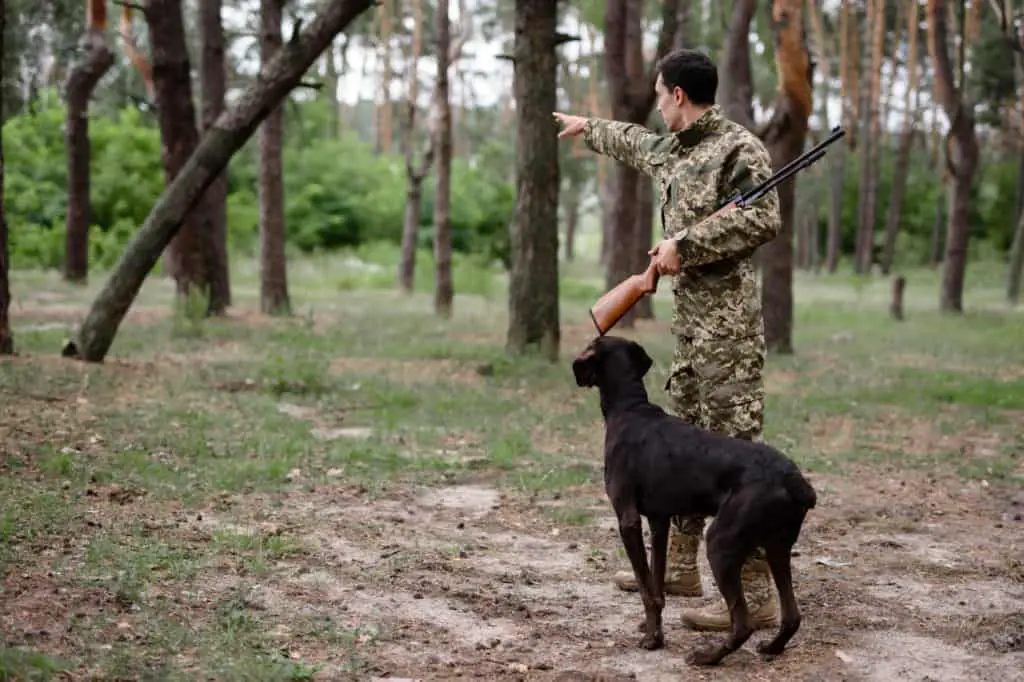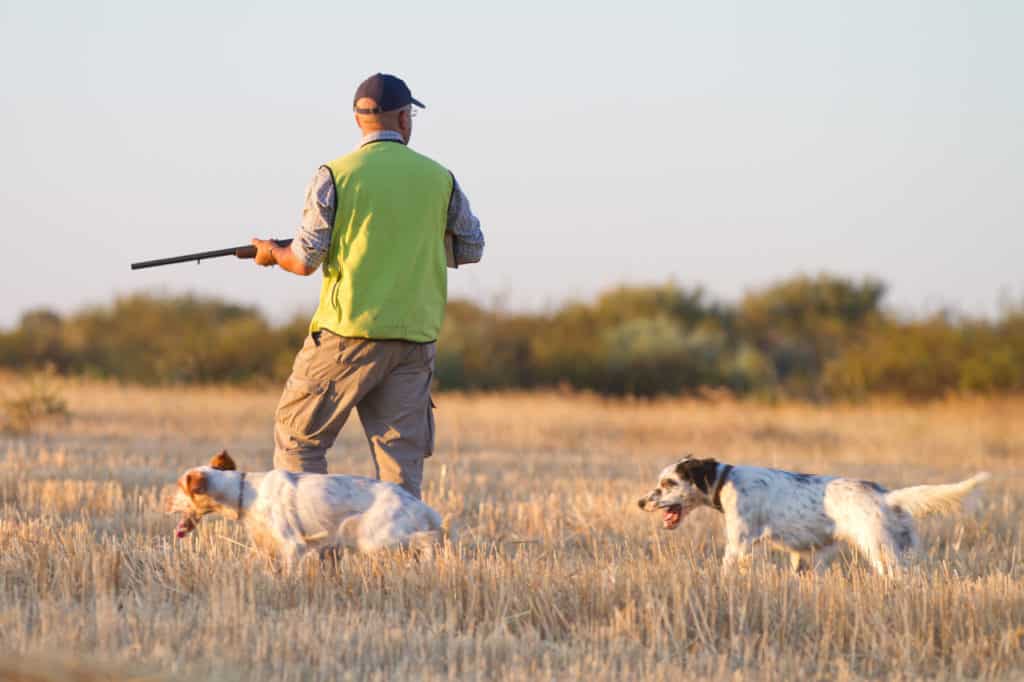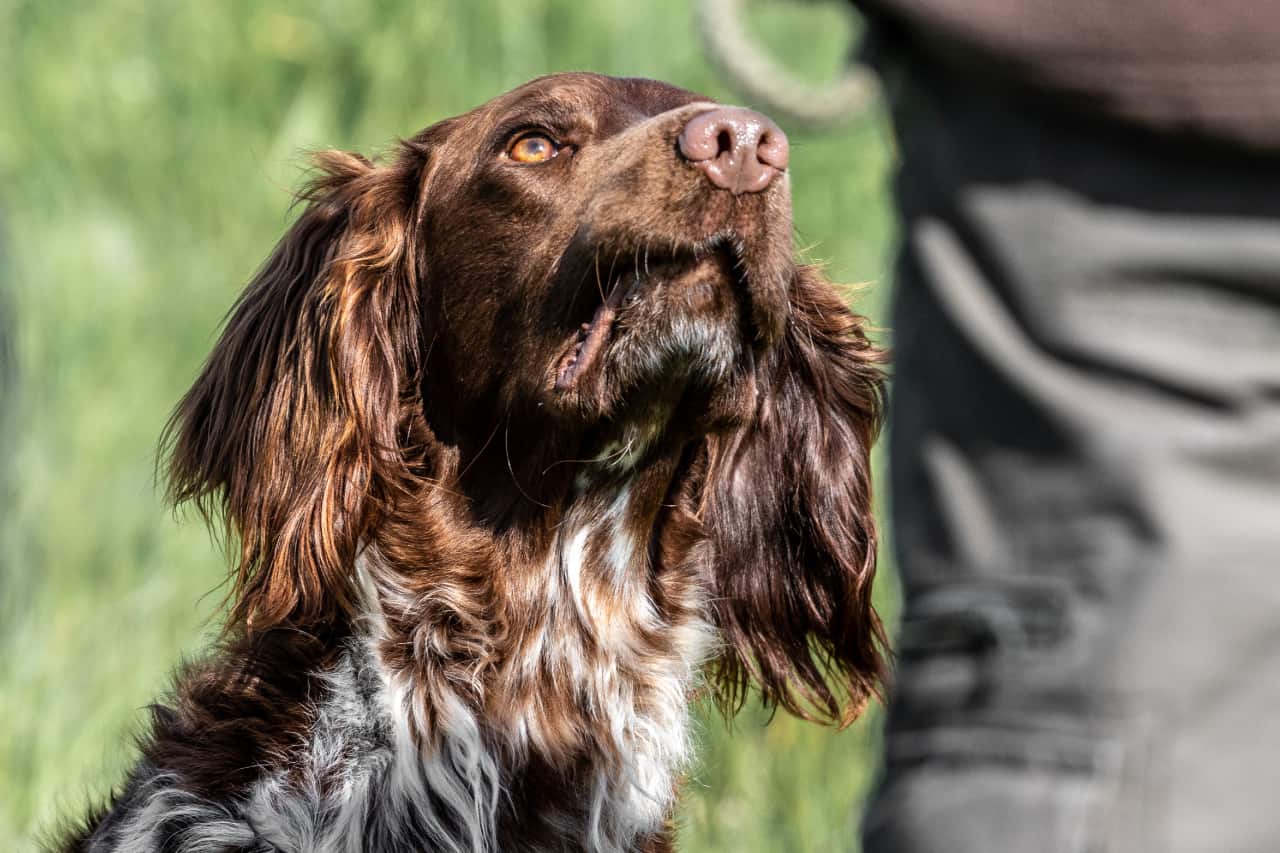Every hunter’s worst nightmare is when he has spent a lot of money and time purchasing a hunting dog only to discover the dog is afraid of gunfire. A cowering scared dog is nobody’s idea of fun. Even worse, your dog may be so fearful that it bolts, and you are left scouring the countryside in search of your dog.
Gun-shy dogs are usually created by bad training. If your dog becomes gun-shy, retrain the dog by eliminating negative associations with gunfire. Create positive associations with gunfire by triggering a hunting instinct. Use ear protection for your dog and ensure that he is healthy.
Several factors contribute to a dog becoming gun-shy. This article will explore those factors and look at ways to remediate and retrain a dog that is afraid of gun-shots. Exposure to gun-shots is an abnormal situation for a dog. As handlers, we must ensure that we give the dog the support he needs to deal with this loud and frightening noise.
How Loud Is A Gun Shot?
Normal conversational speech usually occurs at sixty to sixty-five decibels (60 – 65 dB). The pain threshold is at one hundred and thirty to one hundred and forty decibels (130 – 140 dB). Shotguns have a shot sound explosion of one hundred and fifty decibels to one hundred and sixty-one and a half decibels (150 – 161,5 dB). The gauge and barrel size make a difference. The loudest shot comes from a .30-06 rifle with an eighteen-and-a-half-inch barrel – this shot measures at one hundred and sixty-three point two decibels (163.2 dB).
As you can see, gun-shots are very loud. They are loud enough to cause alarm and pain if a person is not using ear protection or is unaccustomed to the sound. Imagine what an unsuspecting dog experiences if he is suddenly exposed to a muzzle blast.
What Is The Sound Pain Threshold In Dogs?
Dogs have a lower sound pain threshold than people. Their pain threshold is ninety-five decibels (95 dB). Gun-shots would startle most dogs and probably cause a fear-related avoidance behavior such as running away or hiding. Putting it into perspective, the sound of a shotgun is fifty-five to sixty-five decibels above the dog’s pain threshold. When you consider this, you understand why there is a need for careful training with gun dogs.
Hearing Protection For Dogs
Since dogs have a lower pain threshold than the level of gun-shot fire, it becomes a welfare issue that gun dogs should be fitted with hearing protection. There are two basic kinds of hearing protection available for dogs.
- Over-the-ear protection – also known as earmuffs or head sleeves.
- In-the-ear protection – known as earplugs.
Rigid ear muffs are not popular as they often slip and may cover the dog’s eyes. The dogs do not seem to like wearing them. Hearing protection head sleeves are more popular and are used by the U.S military. Head sleeves fit snugly over the head and ears, holding protective hearing devices over the ears.
The earplugs are more comfortable and practical for the dogs to wear. Ideally, they should be custom-fitted for each dog. Some ready-made dog earplugs may be used. Please note that you must not use human earplugs for dogs. Dogs have a different shaped outer ear canal, and the earplug may become lodged in the ear if an incorrect earplug is used. Dogs can hear the handler’s whistles as the material used for hearing protection attenuates certain frequencies more than others. High pitched frequencies such as dog whistles used in hunting are not dampened.
How Does Fear Of Guns Arise?
Fear of guns develops in a dog because the dog experiences the sound of the gun-shot associated with some negative consequences. The negative consequences may be that the dog experiences pain and gets a fright from the loud noise. The dog may be feeling anxious in a new environment and is exposed to gunfire, which makes him associate the gun-shots sound with feelings of anxiety. Incorrect training methods, lack of caution in shooting and training a puppy at the wrong time can also result in a gun-shy dog.
The Dog’s Position In Relation To The Muzzle Blast
A dog positioned close to or forward of the muzzle blast when shooting will experience the full force of the sound explosion. This is enough to cause pain. Caution is needed, and the handler must ensure that, where possible, the dog is situated behind the shooter. This control requires a great deal of training as dogs become excited and begin to creep forward in anticipation of retrieving the target. The handler must work hard to prevent the dog from creeping forward and must at all times know precisely the position of his dog.
Gun Training Errors
Unknowledgeable handlers can cause a dog to become gun-shy by using inferior training methods. Dogs must only be introduced to gun-shots once they are showing confidence and are retrieving consistently. The gun-shot noise should be reduced as much as possible in the beginning. Using a smaller caliber gun or a recorded gun-shot where the volume can be controlled will reduce the sound level.
Handlers who take young puppies to the shooting fields without a proper introduction will cause a lot of trouble for themselves and their dogs. Some handlers believe in a sink or swim approach and will flood the young dog with loud gun-shot noises. If you consider the pain threshold of dogs, you will understand why this approach is unethical, unproductive, and will result in a gun-shy dog.
Old folklore beliefs state that you should fire a gun next to a dog while he is eating to train him to tolerate gunfire. This belief shows a complete lack of awareness of the dogs and no compassion for the pain and distress the dog will go through. There is a high likelihood that a dog exposed to this kind of training will never hunt.
It is essential to try as much as possible to prevent your dog from experiencing other loud bangs such as fireworks or thunder in a negative context before doing gunfire training. The noise phobia can develop from exposure to thunder and fireworks and will generalize to gun-shots.

Fear Periods In A Dog’s Life – A Bad Time To Train For Gun-shots
Puppies experience two fear periods in their lives that are a normal part of their development. The first one occurs between eight and eleven weeks of age. It can differ between individuals but will happen at some stage during these three weeks. Unfortunately, this is often when puppies are going to new homes, and the new owner must be aware of this.
The second period occurs between six and fourteen months. Small breeds tend to experience this fear period at a younger age, and large or giant breeds later. This tendency makes sense when because small breeds mature faster than big breed dogs. It is vital to spend time with your dog and know him well so that you can assess when he is negotiating the fear stage. You can control the environment to prevent the development of phobias.
If you expose a puppy to loud noises such as gunfire during one of these fear periods, you will create a dog with a noise phobia. Owners must assess their dogs and understand the dog’s maturation. You can identify a dog going through a fear period by his behavior. He will lack confidence, be anxious in new situations, respond timidly to new people and animals.
What Age Can You Introduce A Dog To Gunfire?
A dog can be introduced to gunfire at approximately five to six months as a general rule. It is critical to note that each dog matures differently. The owner must assess that the dog is confident and not showing signs of going through a fear stage and is ready to take this big step.
It is not wise to introduce younger puppies to gunfire. They have naturally high fear levels that form part of their survival instincts. Many uneducated trainers can ruin puppies by exposing them to excessive noise too early. The trainer creates a noise phobic puppy, and the dog drops out of the training program as he is considered unsuitable for the work.
The development of noise phobias has some problematic consequences. The first is that dogs are lost from training programs unnecessarily. The second is that these puppies are rehomed to pet homes, but they now have noise phobias. The pet homes are seldom informed of this, and unsuspecting new owners are left to deal with a dog that is afraid of thunder, fireworks, etc. This behavior can be just as problematic in a pet home.
There are horrific instances of dogs killing themselves by jumping through glass windows or impaling themselves on fence poles due to noise phobia and exposure to fireworks. Exposing puppies to excessively loud noises is an unethical practice that should be avoided.
An Older Dog That Suddenly Becomes Gun-Shy
There is a confusing situation where an older dog that showed no fear with gun-shots suddenly becomes gun-shy. There are a few reasons that this can occur.
- The dog may have a negative experience associated with gunfire.
- The dog may have a health issue.
- The dog may experience some other loud noise such as fireworks in a negative situation resulting in fear. Dogs exposed to criminal incidences where gunfire is associated with a lot of human tension and distress may identify with the people’s emotions and associate this with the gun-shots.
A Full Veterinary Check-up
If an older dog becomes afraid of gunfire, you need to have a veterinarian do a complete examination of your dog. it is important as some health conditions can cause hearing sensitivity.
Vets often neglect to inform owners that dogs on corticosteroid therapy can experience a significant increase in noise sensitivity. During the treatment, it is best not to hunt your dog or be highly cautious in assessing if your dog can tolerate gunfire noise. Predominantly white hunting dogs are more likely to have skin allergies that necessitate the use of corticosteroids. Bear this in mind when choosing a gun dog.
Gastrointestinal issues and thyroid problems can also increase noise sensitivity. Cognitive disturbances resulting from brain tumors, senility/ dementia, encephalitis, meningitis, or increased cerebrospinal fluid will have decreased noise tolerance.
A surprising recent result from research shows that dogs with musculoskeletal pain have reduced noise tolerance. The difficulty with noise tolerance can be severe enough to cause a marked noise phobia. Working dogs are more prone to musculoskeletal pain because they are athletes and at risk of injury. The researchers speculate that the dog tenses with exposure to loud noise, which causes pain to the compromised muscles and joints, resulting in noise phobia.
Paradoxically dogs with some hearing loss may begin to show noise phobia. The dog becomes accustomed to living in a relatively quiet world, but the gun-shots are loud enough for the dog to hear. The sudden intrusion of noise is enough to elicit a startle reaction from the dog. A totally deaf dog will not respond at all to a gun-shot. Many hunting dogs develop noise-induced hearing loss from constant exposure to damaging noise from muzzle blasts.
The result is that they have permanent attrition of their hearing which could lead to the above-described situation where they become afraid of loud noises.
How To Deal With A Gun-Shy Dog?
The first step when dealing with a gun-shy dog is a complete veterinary assessment. You need to ascertain if there is any physical element that is causing the noise phobia. If there is a medical reason behind the fear, you need to re-evaluate if it is an issue that can be treated or if the dog needs to be retired from hunting. The veterinarian will be the best professional to help you make this decision.
The second step depends on the age of the dog. If the dog is too young or is going through a fear period, you should give the dog several months to mature. Once mature enough, the dog needs to go through a rehabilitation program. If the dog is old enough, then you should begin retraining the dog. All rehabilitation programs have two main aims:
- Remove negative associations with gun-shots.
- Retrain positive associations with gun-shots.
The third step is to invest in properly fitting ear protection for the dog.

Retraining A Gun-Shy Dog
Use ear protection for your dog during this training so that the dog’s hearing is protected and he does not experience any pain as a result of the noise exposure.
- Start by acclimatizing the dog to general noise that is elevated in volume. This can be done by banging pots, putting on a vacuum cleaner, clapping hands, or beating a drum in the vicinity of the dog. The noise can be produced while the dog is in a room or enclosed in the house. Do not produce the noise right next to the dog – this will defeat your aims immediately. The dog must also be allowed to move away from the noise if he wants. He should be given treats or a chew toy to distract him so that he does not focus on the noise. This activity must be repeated until the dog shows no reaction to the noise.
- Use a recording of thunder, fireworks, or gun-shots where the volume can be controlled and repeat the methodology described above. Start the exposure at forty to fifty decibels. If the dog reacts to this level, decrease it further. If the dog tolerates the noise at this level, increase it in five to ten-decibel increments. This stage may take several weeks to months, depending on the severity of the dog’s fear.
- It is important to use a high-value treat or a toy that the dog finds engrossing.
Retraining The Gun-Shy Dog Outside
Once the dog has had noise exposure within the safe confines of a room or house where he cannot bolt, move the training outside.
- Complete a retrieving exercise with the dog using a high-value item. This can vary amongst dogs. Some dogs will respond well to a ball and others to something more in line with hunting, such as a dead bird. Some trainers prefer to use the dead bird. Expose the dog to the recording of the gun-shots while retrieving the item.
- You can then move on, creating excitement in the dog by using homing pigeons with clipped wings. Usually, just one wing is clipped, allowing the bird to fly still, although not as effective as it normally does. To clip the wing, spread the wing out and clip only the long flight feathers. Throw the pigeon out so that it flies off. Release your dog, which should trigger an enthusiastic hunt response. The pigeon’s slower flying ability due to clipped wings encourages the dog (especially a young dog) to become more engaged in the chase. The pigeon will eventually outpace the dog and fly away. Repeat this until the dog is entirely focused on the target and does not reduce his speed while chasing.
Introducing Gunfire In Retraining A Gun-Shy Dog
Introducing gunfire must be handled carefully and only when the dog is confident in the previous training steps.
- Introduce gunfire by having an assistant fire a small-caliber weapon ( such as a .22) armed with blanks. Fire the gun from ten to twenty feet behind the dog. Shoot in the opposite direction so that the dog does not receive the full sound of the muzzle blast. Throw the pigeon as the gun is shot. The dog should be focused on the target and not the sound of the gun-shot. If you do not have an assistant, then a recording of a gun-shot can be used, and the volume controlled.
- If the dog remains focused on the target, then begin moving the assistant closer to the dog when shooting. Gradually increase the caliber of the gun until you are using the weapon you regularly use.
General Tips For Retraining A Gun-Shy Dog
- The dog must show confidence and excitement at every stage before moving on to the next stage. If there is any fear reaction or timidity, then return to earlier steps and repeat until the dog is confident.
- You can use other dogs to help give confidence to the gun-shy dog and create excitement.
- Some dogs have learned to associate the muzzle blast with the gun, and they will show fear behavior when they see the weapon, even if it is not being shot. This will require retraining so that the dog associates the presence of the gun with a positive experience. Put the gun in a room or in an area where the dog can see it. Play a game or give a treat to the dog. Gradually bring the gun closer until the dog learns to tolerate the gun’s presence while playing a game or doing obedience training with lots of treats used to reward him.
A note on the ethics of using a pigeon with clipped wings: some people feel it is unethical to use a pigeon with clipped wings. The pigeon is not harmed as it is usually still faster than the dog. It is possible to do this exercise with a pigeon with unclipped wings. It does, however, make it more difficult as the pigeon is apt to fly straight up when released, which may not trigger the dog’s hunting instinct.
How To Prevent A Dog From Becoming Gun-Shy
There are some practices that the handler can employ to prevent his dogs from becoming gun shy.
- Take the dog onto a hunting field and practice retrieval, flushing, and general obedience without using a gun. The dog will become accustomed to being in different places and will become excited when hunting.
- The hunter should practice shooting at a range so that there is a minimum amount of gunfire while hunting. Practice one-shot kills, reducing the need for multiple shots. This skill saves the hunter’s hearing, the dog’s hearing, lessens the number of muzzle blast exposures, and reduces ammunition use.
- Do not fire your gun while your dog is just in front of you. The dog will receive the entire total volume of the muzzle blast.
- Keep the dog several feet behind you if possible when shooting.
- Obedience is critical if your dog is to stay safe during shooting and for you to control his position in relation to the muzzle blast. Practice obedience in situations other than shooting.
- Train your dog correctly with gradual exposure to gunfire.
- Never expose a young puppy to gunfire or train while the puppy is going through a fear period.
- Use ear protection.
- If you are hunting from a blind, the blind can be lined with noise-reducing material.
Choose The Correct Dog
There is evidence that certain genetic lines in dogs will be more prone to being highly strung and more likely to develop a noise phobia. It is critical when choosing your puppy to research the breeder and his dogs to ensure you select a dog capable of the work you want him to do. The breeder should preferably hunt his dogs or compete them in field trials.
Ask the breeder what his approach is to raising his puppies. Ask an open-ended question without giving any indication of what your standpoint is. If the breeder claims that he tests his puppies by shooting in their close vicinity, avoid purchasing any of his puppies. The breeder should also have a solid program of socializing the puppies as unsocialized puppies are more likely to be generally fearful and will develop into anxious adults.
Do not purchase a puppy from any breeder who allows his puppies to be taken to be rehomed before eight weeks of age. Research has shown that puppies that leave their littermates and mother before eight weeks are prone to developing anxiety and fear-related behaviors.
Conclusion
It is better to avoid creating a gun-shy dog than to deal with retraining a dog with a gun phobia. Choosing a dog from proven bloodlines lessens the likelihood of problems developing. Train your dog correctly and at the right time of his life. Retraining a gun-shy dog is hard work requiring a lot of patience, but it can be done. Check your dog for health issues if he suddenly becomes afraid of gun-shots.
References
http://ice.ucdavis.edu/~robyn/Korina/BCIdeas/Criticalperiodsinpuppydevelopment.html
https://www.ducks.org/hunting/retriever-training/overcoming-a-fear-of-gunfire
https://earinc.com/gunfire-noise-level-reference-chart/
https://www.ncbi.nlm.nih.gov/pmc/articles/PMC5816950/
http://ice.ucdavis.edu/~robyn/Korina/BCIdeas/Criticalperiodsinpuppydevelopment.html

